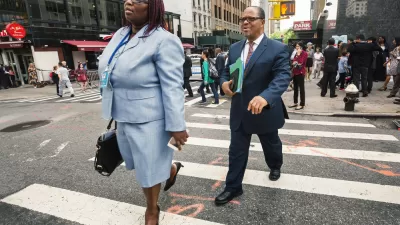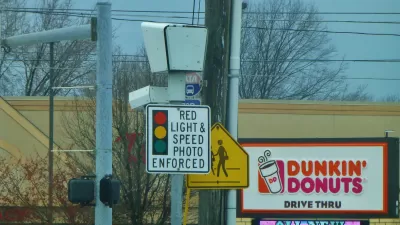In 2017, New York's highest court held that cities could be held liable for failure to adopt traffic calming policies. Why hasn't this ruling led to safer streets?

On December 5, 2004, 12-year-old Anthony Turturro was riding a bicycle in Gerritsen Avenue in Brooklyn, New York, when he was struck by a motorist who was driving 54 miles per hour. In addition to suing the motorist, Turturro and his mother sued the city, presenting evidence that speeding was common on Gerritsen Avenue and that the city had not studied “traffic calming” measures—that is, measures such as street humps and narrower street lanes that are likely to slow down traffic and thus preventing crashes. The jury found that the city was negligent, and in 2016 the New York Court of Appeals (New York's highest court) affirmed the verdict.
At first, pedestrian advocates were exultant. For example, Paul Steely White of Transportation Alternatives* stated: “This ruling from New York’s highest court puts an end to the notion that traffic safety improvements should be subject to debate and contingent on unanimous local opinion." However, it is not clear to me that this ruling has had as much impact as street safety activists hoped: no case outside New York has relied on it, and even in New York City, street safety improvements still get slowed down (pun intended!). For example, the city has delayed plans to slow down traffic on a six-lane stretch of Amsterdam Avenue in Harlem, because a local community board objects to slowing down car traffic. Why has the city continued to follow business-as-usual policies, rather than changing its policies to reflect the risk of tort liability?
To understand the limits of Turturro, we have to read the decision more carefully. In that case, the city argued that plaintiffs had not shown that traffic calming would have prevented the collision at issue. The court rejected this argument, pointing out that even the city’s expert admitted that “people generally drive faster on wide, straight roadways…[and that] traffic calming measures are intended to reduce the overall ‘curve’ of speed.” Accordingly, the jury could reasonably “have concluded that traffic calming measures deter drivers such as [the motorist in this case] from speeding, and that the City’s failure to conduct a traffic calming study was a substantial factor in causing the accident (emphasis added).”
In other words, the key factor in Turturro was not just that the city failed to calm traffic, but also that (despite ample warning in the form of complaints from neighborhood residents) the city failed to even study calming traffic. If the city can plausibly claim that it has studied traffic calming alternatives and made a reasoned decision to reject those alternatives, it can get away with business-as-usual policies. The Turturro court also mentioned that neighborhood residents had repeatedly complained about speeding on Gerritsen Avenue; thus, it is not clear that the city would have been held negligent in the absence of such complaints.
Moreover, Turturro rests on a view of sovereign immunity that is unusually narrow. In most states, the doctrine of "discretionary function" immunity often protects municipalities for liability for negligent street design. Under this doctrine, the city is not liable for damages caused by negligent policy decisions, as opposed to individual acts of carelessness. However, New York does not apply this doctrine to street design cases. The New York courts instead divide government actions into "proprietary" and "governmental" functions, and further hold that street design is a "proprietary function" and thus rarely protected by sovereign immunity.** Because many states do not apply the governmental/proprietary distinction, Turturro may not be relevant to most states.
In sum, a New York municipality can be held liable for negligently failing to calm traffic. But unless the courts interpret Turturro more broadly in the future, this may be true only where the municipality responded to citizen complaints by failing to study the issue.
*In the interests of full disclosure, I note that I am a dues-paying members of this organization.
**I note, however, that even under New York law a city is immune from liability for negligent street design where "a duly authorized public planning body has entertained and passed on the very same question of risk as would ordinarily go to the jury." (Turturro). For example, in Enker v. County of Sullivan, the court rejected the claim of an injured pedestrian because the county's "installation of pedestrian push signals ... was a deliberate and reasonable planning decision made to ensure the safety of pedestrians while navigating the subject intersection, which is the 'very same question of risk' underlying plaintiffs' claim."

Planetizen Federal Action Tracker
A weekly monitor of how Trump’s orders and actions are impacting planners and planning in America.

San Francisco's School District Spent $105M To Build Affordable Housing for Teachers — And That's Just the Beginning
SFUSD joins a growing list of school districts using their land holdings to address housing affordability challenges faced by their own employees.

The Tiny, Adorable $7,000 Car Turning Japan Onto EVs
The single seat Mibot charges from a regular plug as quickly as an iPad, and is about half the price of an average EV.

Seattle's Plan for Adopting Driverless Cars
Equity, safety, accessibility and affordability are front of mind as the city prepares for robotaxis and other autonomous vehicles.

As Trump Phases Out FEMA, Is It Time to Flee the Floodplains?
With less federal funding available for disaster relief efforts, the need to relocate at-risk communities is more urgent than ever.

With Protected Lanes, 460% More People Commute by Bike
For those needing more ammo, more data proving what we already knew is here.
Urban Design for Planners 1: Software Tools
This six-course series explores essential urban design concepts using open source software and equips planners with the tools they need to participate fully in the urban design process.
Planning for Universal Design
Learn the tools for implementing Universal Design in planning regulations.
Smith Gee Studio
City of Charlotte
City of Camden Redevelopment Agency
City of Astoria
Transportation Research & Education Center (TREC) at Portland State University
US High Speed Rail Association
City of Camden Redevelopment Agency
Municipality of Princeton (NJ)






























